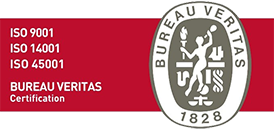Products
DEZA a.s. is one of the leading businesses in coal tar and crude benzol processing in Europe. These two primary components form basis for manufacturing of wide spectrum of matter used as raw materials in industries relying on our products. The results of this business process can be found everywhere: scores of plastic, resin and aluminium products that permeate our lives, in rubber-based products as well as pigments and dyes. Several production methods require more unique processes to achieve specific qualities such as moth elimination or wood oil impregnation.
Tar pitch
Tar pitch is a term for distilled remnants of a distillation process of coal tar. Coal tar is a byproduct of coke production. Consequently coke can be used during crude iron production. Due to high content of carbon and the ability to maintain liquid consistency in high temperatures tar pitch plays a key role in manufacture of special carbon-based materials. The principal application of tar pitch is to serve as a coke binding agent during carbon and graphite electrodes during production of steel and aluminium. Tar pitch is produced in different specifications based on customers' requests.
Tar Oil
Various tar oils and tar pitch are the result of distillation of tar. Some tar oils are used for production of cleaning agents, e.g. naphthalene, anthracene and carbazole. Other tar oils are used as compounds, primarily creosote oil and carbon black oil and wash oil. Creosote oil is used for pressure impregnation of railroad timber ties and timber posts. The most common use of carbon black, which is made from carbon black oil, is as hardening agents in tires and other rubber-derived products. Wash oil is used in coke plants for separating crude benzol from coke gas and other special purposes.
|
Binder Pitch Chemical name: Pitch, coal tar, high-temp. |
Wash Oil: Chemical name: Creosote oil, acenaphthene fraction-wash oil |
|
Impregnation pitch Chemical name: Pitch, coal tar, high-temp. |
Anthracene oil fraction II Chemical name: -heavy anthracene oil fraction II-wash oil |
|
Carbon black feedstock Chemical name: -none |
Tar oil Chemical name: -none |
Esters (Plasticizers)
Phthalic anhydride is produced by oxidizing naphthalene. Phthalic anhydride is used in the production of colouring agents, pharmaceuticals, resin and plasticizers for PVC.
|
Phthalic Anhydride molten/flakes Chemical name: Phthalic Anhydride |
Diisononylphthalate (DINP) Chemical name: Diisononylphthalate |
|
Dipropylheptylphthalate (DPHP) Chemical name: bis(2-propylheptyl)- phthalate |
Dibutylphthalate (DBP) Chemical name: Dibutylphthalate |
|
Dioctyladipate (DOA) Chemical name: bis(2-ethylhexyl) adipate |
|
Benzene
Benzene is the main component of crude benzol that is formed by washing of coke gas in a coke plant. Highly refined benzene is produced by hydrogenation refining and subsequent distillation of benzol. Benzene forms a primary element in many polymers used in daily life such as polystyrene, PET, nylon, polycarbonates, polyurethanes, etc...
chemical name: benzene
CAS: 71-43-2
Aromatic solvents
Toluene, xylene and solvent naphtha are secondary components of coke benzol. These substances and their substrates are derived from crude benzol by hydrogenation refining and distillation. Toluene is one of the most commonly used organic solvents. Toluene is used as a solvent in paints and varnishes; it is also used during production of rubber products, adhesives, silicone mastics and sealants. It also finds several medical applications. As a raw material toluene is used for production of benzoic acid and toluene-diisocyanate that is the primary element of polyurethane foams.Toluene is also used to increase the octane rating of gasoline for racing engines. Xylenes and solvent naphtha find their application in solvents in paints, varnishes, adhesives and sealants.
|
Toluene 99% Chemical name: toluene |
Xylene - technical grade Chemical name: mixture of o,m,p-xylene and ethylbenzene |
|
BTX fraction Chemical name: Distillates (coal tar), benzene fraction, BTX-rich |
Solvent naphtha Chemical name: Aromatic hydrocarbons, benzene distn. |
Sulphur and sodium bicarbonate
Sulphur and sodium bicarbonate are byproducts formed during production of other substances that find wide application in manufacturing of varied chemical products.
|
Sodium Bicarbonate – aqueous solution (20–25%) Chemical name: sodium carbonate |
Sulfur 99% - liquid Chemical name: sulfur |
Phenols, cresols, tar acids
Oil (along with other substances) with a high phenolic content is produced by distillation of tar oils. By extracting acidic phenols and subsequent distillation of this oil, pure phenol and mixtures of phenols, cresols and xylenols are produced. Phenol is the basic raw material of bisphenol A, the condensation of which with other substances produces polycarbonates and epoxy resins. Phenol, cresols and xylenols are the basic ingredients for phenolic resins.
|
Phenol 99% Chemical name: phenol |
o-Cresol 99% Chemical name: o-cresol |
|
m,p-Cresol - mixture Chemical name: Tar acids, methylphenol fraction |
Chemical name: Tar acids, xylenol fraction |
|
3.5-Xylenol fraction Chemical name: Tar acids, 3.5-xylenol fraction |
3.5-Xylenol 99% Chemical name: 3.5-xylenol |
Naphthalene
Naphthalene is present in coal tar in the amount of about 10%. Naphthalene oil is separated from the tar by distillation, which is further purified by distillation and refining after the removal of phenols. The resulting product is produced in two qualities, technical naphthalene with a naphthalene concentration of over 97% and pure naphthalene with a purity of over 99%. In addition to the production of phthalic anhydride, naphthalene is used for the production of surfactants, pigments, dyes, medications, and other chemicals. Naphthalene is known primarily as a moth killer, well known for destroying clothes. Recently, the importance of naphthalene has grown as a raw material for the production of superplasticizers for concrete. Hydrogenated or partially hydrogenated naphthalene is used as a low-volatile organic solvent.
|
Technical Naphthalene 97% Chemical name: naphthalene |
Refined Naphthalene 99% Chemical name: naphthalene |
Specialty Aromatic products
Oil with a high concentration of anthracene and carbazole is produced by distillation of tar oils, among other substances. Pure anthracene and carbazole substances are produced by subsequent crystallization in combination with highly effective vacuum distillation. Pure carbazole is used to make pigments and pharmaceuticals. In addition to pharmaceuticals, dyes, and insecticides, pure anthracene is used to make anthraquinone. In addition, anthracene is a UV-sensitive substance and thus has a number of special uses. Anthraquinone is produced from anthracene in the Organik plant in Otrokovice. The production of anthraquinone takes place on a special catalyst, which we can make ourselves for this purpose. Anthraquinone is most commonly used as an additive in paper production.
|
Anthracene Chemical name: anthracene |
Carbazole Chemical name: carbazole |
|
Anthraquinone Chemical name: anthraquinone |
Acenaphthene Chemical name: acenaphthene |
|
Tetraline Chemical name: 1,2,3,4-tetrahydronaphthalene |
Pyrene Chemical name: pyrene |




